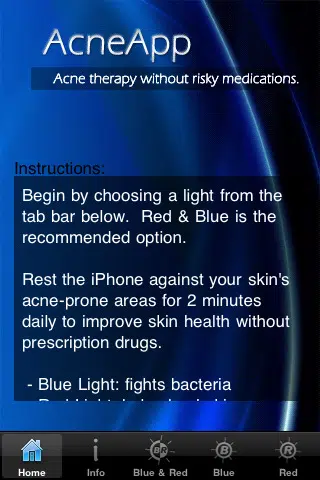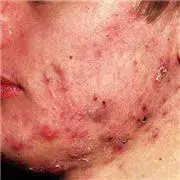Can An Apple iPhone App Cure Acne?
iPhone owners really like their apps, so it is no big surprise that apps to deal with acne – such as AcneApp, a light-based treatment – have drawn interest from folks who like the idea of zapping pimples while chatting to friends.
It is supposed to operate like this: download the application and hold the cell phone towards the skin so the light treatment can do its work. Do some multitasking if you like, keeping in mind to switch sides so your whole face benefits from the procedure.
More than a year after release, there’s still no clear evidence to prove it actually works.
Apps confusion
 The less-than-$2 ‘AcneApp’ is less expensive than a lot of over the counter acne remedies and is listed within the health-related category of iTunes. The web retailer page for the app carries glowing user reviews, such as: “This app is most likely the greatest thing ever to surface; i’ve had issues with my skin for years. Acne app is simple to make use of and you are able to use it at any time of the day.” Yet another raves: “IT Works!!! I Love IT!!“ However, elsewhere on the page, there’s the caution: ”the app is for entertainment purposes only and isn’t intended for treatment of any disease or health-related condition”.
The less-than-$2 ‘AcneApp’ is less expensive than a lot of over the counter acne remedies and is listed within the health-related category of iTunes. The web retailer page for the app carries glowing user reviews, such as: “This app is most likely the greatest thing ever to surface; i’ve had issues with my skin for years. Acne app is simple to make use of and you are able to use it at any time of the day.” Yet another raves: “IT Works!!! I Love IT!!“ However, elsewhere on the page, there’s the caution: ”the app is for entertainment purposes only and isn’t intended for treatment of any disease or health-related condition”.
‘Acne Away – Pimple and Blemish Treatment’ is less expensive at less than a dollar and claims, “Studies have shown blue and red light acne therapies eliminate most acne causing bacteria and decrease skin blemishes by 73%. (Source British Journal of Dermatology)”.
Dermatologist reaction
Nevertheless, the British Association of Dermatologists says cell phone treatment won’t do the job.
Nina Goad, Communications Manager for the British Association of Dermatologists and British Skin Foundation, tells us by email: “The study mentioned from the British Journal of Dermatology doesn’t refer to the kind of light that would be emitted by a cell phone. This application won’t take care of acne and isn’t a substitute for clinically proven treatment options readily available from a physician.”
Though the wavelength of light employed in the AcneApp is comparable to that employed in dermatologists’ light treatments, the intensity of the light utilized by dermatologists is at least thousands of times greater, says Dr David Pariser, president of the American Academy of Dermatology. “I would be extremely surprised if there’s sufficient intensity from the light [from AcneApp] to make any significant difference.”
Proof?
AcneApp was developed by a US dermatologist Dr Greg Pearson. WebMD emailed his firm asking for comment, but have not received a reply.
In a YouTube video, Pearson explained that the app must be applied directly towards the skin for about two minutes a day. Whilst admitting that research were required, he said that the concept is ”really based on some science”.
When the app is downloaded, buyers are asked to select a light selection, with the red and blue alternating light recommended.
Based on the product data, the device gives off wavelengths of 420 nanometers of blue light and 660 nanometers of red. Blue light, according to the app, fights acne-causing bacteria, whilst red light helps heal skin.
Customers are warned not to make use of the app if they’re on medication that makes the skin light very sensitive or if they have health-related conditions that make the skin hypersensitive to light. They’re cautioned to stop making use of AcneApp if issues develop.
What’s the evidence behind light treatment of acne?
The Apple retailer cites a study inside the British Journal of Dermatology finding light treatment effective for acne and nearly twice as powerful as benzoyl peroxide, a widespread ingredient in over-the-counter blemish products.
Researchers from Imperial College, London, did publish a review in that journal in June 2009. The researchers identified and reviewed the outcomes of 25 trials, some making use of light treatment and some using light treatment in combination with topical acne therapy. They concluded that the research show that red and blue light was much more successful than topical benzoyl peroxide within the short term, but they cautioned that very few of the scientific tests compared light treatment directly with conventional acne therapy, and several studies weren’t long-term.
Apple UK has not responded to requests for info about health-related claims and proof required prior to allowing these apps onto its store.
So apart from wasting $2 or less and still coping with zits, is there any possible harm? Dermatologists say there’s some possible risk from bacteria on the phone that could lead to a skin infection, but that’s probably the only risk apart from lack of any benefit!
LINESPACE
Related Blogs
- Skin Care Treatments for Changing Weather | Natural Holistic Health Blog
- A Guide To Acne Skin Care | LIFE AND HUMANITY

